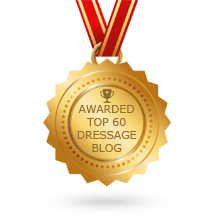|
This month I’m taking a look at some footage of dressage shown at the 2021 Tokyo Olympics. The video is of Canadian rider Brittany Fraser-Beaulieu riding the transition between passage and piaffe. You can watch the full test here https://www.youtube.com/watch?v=qGSYdsItiqU. I am focusing on the quality of the passage, the transition into piaffe and the piaffe itself. This is a complicated sequence of movements that require the rider to have great tact and timing of the aids. The passage starts at 5 minutes 37 seconds as the pair come out of the extended trot. The rider makes a backward movement on the reins which contracts the horse’s head and neck position creating a passage that lacks suspension. The steps are uneven, showing a breakdown in the diagonal movement of the horse’s legs because the horse is unable to correctly bring its haunches under due to the contraction in its neck and braced back. As they turn out of the corner, the horse’s inside leg hind is disengaged and it has braced its ribcage placing weight in its forehand. The horse loses balance and rhythm through the turn from the long side (5:44) As the horse approaches the piaffe transition, the rider makes several heavy backward movements on the reins, causing the horse to open its mouth and cross its jaw, and for the trot rhythm to falter (5:51). In the piaffe steps, the horse is contracted in its neck and disengaged in its hind legs placing weight in its shoulders with no engagement of the haunches.
The next sequence of pictures shows the horse with its right hind leg moving straight up and down, whilst the left hind leg swings outwards. At the top of the step there is a circular movement of the foot, and the left foot moves inwards as it is replaced on the ground. The horse starts to swing its haunches from side to side with greater disruption to the diagonal pairing in the stride. The piaffe is incorrect and beyond improvement (sequence of stills from 5.52 to 5:55). © Training Riders, Transforming Horses Comments are closed.
|
AuthorDiane Followell Classical Dressage Trainer 
|
Telephone+44 (0)7931551014
|
|
© Diane Followell 2015 -2024.
All Rights Reserved.
All images and content are copyright Diane Followell unless otherwise stated.
All Rights Reserved.
All images and content are copyright Diane Followell unless otherwise stated.












 RSS Feed
RSS Feed

